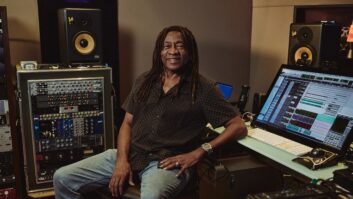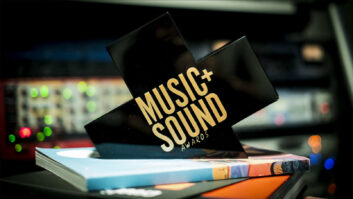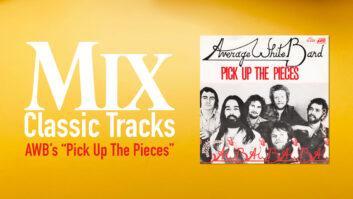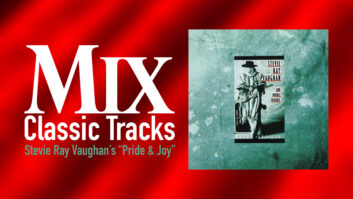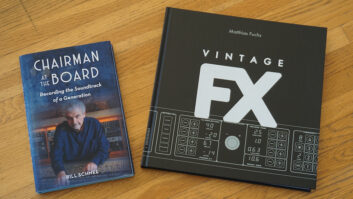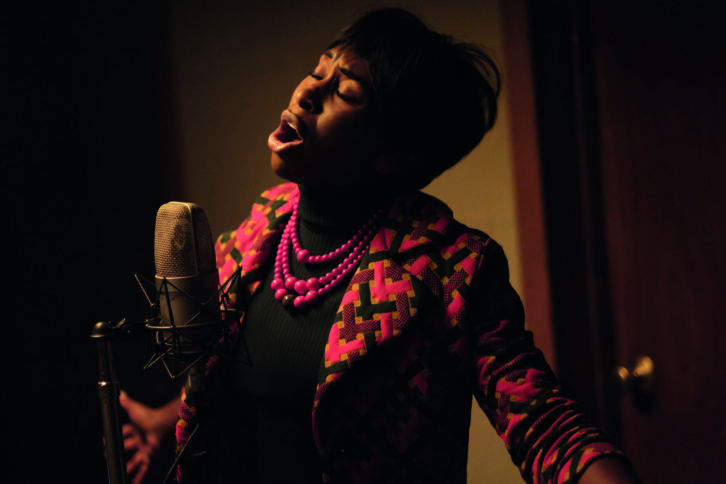
One day in early December 2019, Jamelle Adisa, who works with artist/producer Raphael Saadiq, stood in an Atlanta studio and watched as actress Cynthia Erivo belted out “I Never Loved a Man” in her full Aretha Franklin incarnation.
Sitting at a piano and singing a cappella, Erivo was delivering live vocals to camera, to playback in her earpiece of the reproduced backing track Adisa had created a month earlier in Los Angeles. Actors portraying the original Muscle Shoals Rhythm Section quietly played along on a set that reproduced the legendary FAME Studios. “We’re in good hands on this,” Adisa smiled.
Saadiq, executive music producer on the film, and Adisa had been tasked with re-creating the sound of some of Franklin’s most cherished recordings for the late-March premiere of National Geographic Channel’s Genius: Aretha, the third season of the network’s popular Genius series.
Erivo had apparently decided quite early on that she wanted to sing live—and be recorded—on set, not lip syncing to a pre-recorded vocal track.
“We naturally wanted to record everything in the studio,” says Saadiq. “But Aretha was a live player, whether it’s singing in a church or a venue. And Cynthia wanted to get as much of a natural, live feel as she could.” The Saadiq-Adisa-Erivo tracks complement Terrence Blanchard’s beautiful score recordings, which were tracked after episodes were completed earlier this year.
The backing tracks Erivo sang to represent not only the well-known recorded masters released by Franklin, but also live and filmed recordings, all well-known to fans. The songs were selected by showrunner Suzan-Lori Parks, representing specific, important moments in Franklin’s life, requiring subtle tonal changes that occurred over time. It was also key that they produced mixes that did not sound completely of their time.
“We really wanted to nail the arrangement and stay true to the styles more than anything,” adds Music Supervisor Jen Ross. “It’s not about re-creating the recording, but really about honoring the tonal emotion behind it, about her genius.”
PRE-RECORDING THE BAND
Tracking took place at Saadiq’s Blakeslee Recording Studios in North Hollywood, a space he acquired back in 2002. The facility has three large live rooms, a mix room and a large warehouse, which can serve as a soundstage when needed. The biggest of the live rooms, Studio A, is large enough to fit a 50-piece orchestra, its walls packed with cool and unusual pieces of gear Saadiq has collected over the years. “It’s a candy shop, man,” says his engineer, Hotae Alexander Jang.
The control room is similarly stocked with vintage gear, including Scully 280 and Neve 1073 mic preamps, Universal Audio LA-2As, which Jang found the perfect component to handle bass tracks for the sessions. “The Scully 280s really give us the sound we usually make here—flubby, woolly, warm analog tape—which was perfect for the drum sounds on this,” he describes. He also makes ample use of a vintage. “We’ll also put guitars or drum mics through [an Ampex tube 4-channel mic and line-in mixer] to sum, to make a 2-mix.”
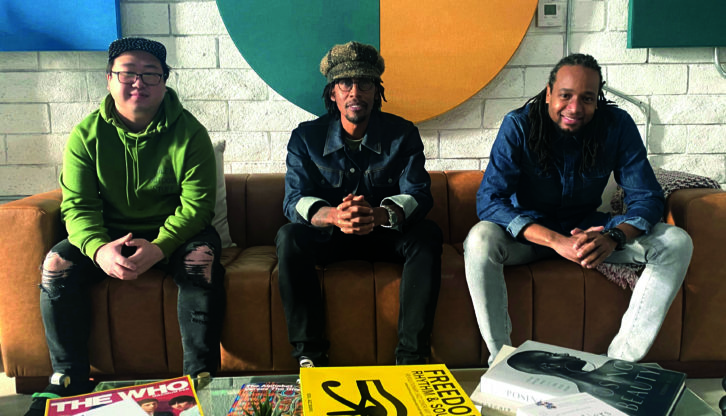
He describes the console like most of the gear in the studio, much of which has been altered to serve Saadiq’s needs. “It’s an SSL 4000E, but it’s a Frankensteined SSL!” he laughs. “There are some G Series channel strips in there. I fight with it every day. But I love it.”
While the songs were initially tracked to the studio’s Studer A827 24-track tape machine, production shifted to Pro Tools after a month’s recording. “We started isolating instruments a little better, and they wanted us to roll the dirt back some,” Jang explains. “But I made sure, before I sent out deliverables, that we still had the Blakeslee sound; we had to sneak in a little bit of dirt.”
Saadiq and Adisa assembled a core cadre of prime players for the sessions, who made certain to try to match both instruments and amps to the original recordings. Players included Erick Walls on guitar (playing through a Fender 68 Princeton Reverb, miked with a Shure Unidyne 545SD and RCA 77DX, passed through the Ampex mixer), bassist Dmitry Gorodetsky, drummer Carl Lemar Carter, and keyboardists Matt Jones and Ernest Turner, among others. Adisa, a respected trumpet player, led the horn section, which included Rickey Woodard doubling the legendary King Curtis.
In keeping with the goal of recording as close as possible to original Aretha masters, the initial process involved matching the original tempo. Jang would create a click track in Pro Tools, matching as best as possible the BPM of the original, though the process would evolve later in a big way.
In scenes that would depict studio sessions, Aretha is sometimes seen working with the musicians to flesh out a tune, as seen in the first episode, for example, in a montage of quick cuts of different passes. For those scenes, Adisa, who would develop his arrangements in Logic, had to come up with a variety of styles for the countless attempts seen onscreen. “We would start with just recording the full song, as it is on the released master,” he explains, “and then we would reverse engineer from there. How would we get into the song if there’s a brand new idea? It was fun, actually. For arrangements, I just thought, ‘Well, what was popular at that time? Okay, shuffles, triplet feels, Fats Domino-type styles. Maybe a ballad, maybe this.’ So we just did a deep dive.”
In post, Music Editor Marvin Morris and Re-Recording Mixer Dan Brennan made use of “B-roll” leftover session bits requested from Adisa, of musicians noodling around on their instruments between takes.
“Even though they’re not on camera, we might have a guy talking to Aretha,” Morris describes. “She might be sitting at the piano, getting ready. But you still have the drummer back there, maybe he’s tuning up his drums, or the bass player’s running through the chart, trying to get his licks right, until the singer says, ‘Okay, guys, let’s take one.’ If you’ve ever been in a session, you know how hard it is to get those guys to calm down for a second and focus!” he laughs.
When mixing, Brennan, working out of Soundtrack New York alongside dialog mixer Ken Hahn, would carefully wait until the pass in the scene that produces the final, known master, before applying a mix that closely mimics that song’s known mix. “There’s a moment in there, where the band’s working with her, and they’re trying to find it—they haven’t found the magic yet. You have to save a little of the polish until it clicks, for that fun moment when the magic happens. Then it’s ‘Let’s sparkle it it up a bit, give it more of that album feel, less ‘We’re in the studio with them.’ If you think of one of these songs in your head, you have an idea of what it sounds like. So you want it to feel the way you remember it.”
Brennan use tools such as Fab Filter plug-ins and tape emulation to bring in some of that feel, but introducing the kind of distortion on vocals, horns, etc., existent in original vinyl masters—and remembered by fans—would cross the line. “If you try to match that against what’s onscreen, trying to be with these people and buy the dialog, it just doesn’t fit. We want it to hopefully feel like she’s in your living room, playing in studio for you.”
RECORDING VOCALS ON SET
The on-set recording and playback systems were set up by veteran Production Sound Mixer Jay Meagher, who recorded to a Zaxcom Deva 24 with the Mix 16 moving fader platform, backed up with an Aaton Digital Cantar X3 24-track recorder. Atlanta local John Maskew provided playback for Erivo, as well as recorded any instrumentation that might have been tracked.
But the most important elements of the system were microphones. While boom operator Brian Didsbury employed Sennheiser MKH50s to pick up dialog, the microphones Erivo is seen singing into had to serve two purposes: they had to represent history, and they had to provide a healthy vocal recording.
“I had one stipulation,” Meagher states. “I wanted everything to be historically true to the time. If she’s got a microphone in front of her face and she’s singing, it’s going to be practical. And that set the bar pretty high, to find some of these microphones that, first of all, would work, and then, if not, that we could manipulate them to work for us.”
Didsbury, it turns out, is an aficionado of this specific era of soul music and performance, and was able to easily identify period microphones. Meagher then worked with the prop department to source shells of those mics, some supplied by Vermont-based Sonic Circus.
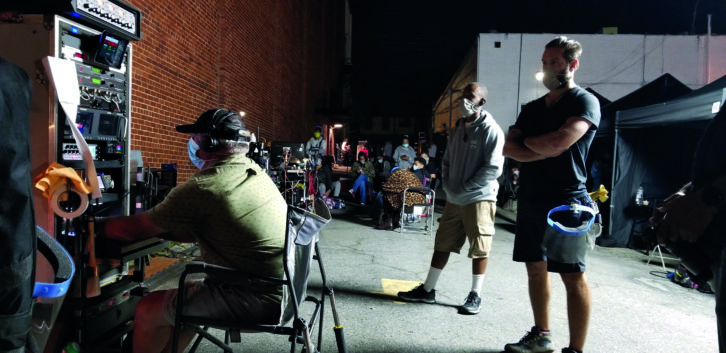
“They have a lot of vintage equipment,” Meagher explains. “And whatever they had that didn’t work, we could use their shells and put contemporary guts from other microphones in them.” The Unidyne Shure that Erivo is seen singing to in earlier episodes was actually fitted with a Schoeps MK-41 capsule. The Electro-Voice 576 and 667s seen in the “Amazing Grace” episode also contain Schoeps elements.
For studio sequences, getting real Neumann U47s was, financially, out of the question, so Meagher acquired U47 replica mics made by FLEA. “U47s are iconic for those Muscle Shoals and Atlantic sessions,” he says. “So we bought those.” Powering them was a pair of racks he kept, featuring Universal 4-channel 710 preamps. “Those really wake up those vintage, big-diaphragm microphones.”
Maskew’s playback rig is centered around Pro Tools Ultimate, run on a Macbook Pro. He uses MOTU audio interfaces, the main one a 28-in, 30-out 828x with Thunderbolt connection. He uses Electro-Voice ZLX-15P powered speakers, often to provide 50Hz “thump tracks” on set. “They get our backgrounds moving in sync with the music when we’re trying to capture clean dialog,” he explains.
Maskew sends Erivo a mono playback mix (prepared by Adisa) from his Comtek transmitter to a tiny Phonak Invisity earwig in-ear receiver. Music will begin playing out in the room via the EV 15Ps, switching to the earwigs when recording either her vocal or dialog.
Meagher, meanwhile, would back-feed Erivo’s vocal tracks he had recorded to Maskew, so that he could give Adisa work mixes that included multitracks of the instrumentation. Maskew, if recording instrumentation on set, would track to Pro Tools while providing a 2-track stereo mix to Meagher, who would track to his system live. That, with vocal, was provided to picture editorial.
BACK TO THE ORIGINALS
While the intention was to have the Music Department create a backing track for Erivo to hear in her earpiece while singing, that only lasted for the show’s first episode. By the time Franklin is seen on The Steve Allen Show performing a version of “Skylark” in episode two, the actress had asked for a change.
The cool jazz arrangement heard on the original broadcast had been transcribed by Adisa, but, Maskew notes, “She really wanted to do it exactly like the live performance. So I quickly ripped it from YouTube and fed it to her earwig. And once she got a taste of this method, that’s when she started requesting to have the original Aretha tracks for each of her performance scenes.”
The problem was that once her vocal track was sent back to Blakeslee for Adisa to marry to their backing track, the two didn’t match. His was recorded to a click track that came close to the original master, and hers was sung specifically to the original master.
“We would find we had to adjust our instrumental in certain spots, doing some retrofitting and praying to the gods of Ableton!” Adisa says, noting his use of the software for time compression and expansion of bits of music to match Erivo’s vocal. “It’s a lot more stable for that than Pro Tools.”
By the following episode, after wrestling in the same way with tracks for “A Change Is Gonna Come,” Morris notes, “That’s the one that really alerted everybody to what’s going on. It was just a bear to get it in sync when I got it back from set. That’s when we put a pause on things to figure out what we could do to not make it such a big headache for everybody.”
The decision was made that from then on Saadiq’s musicians would track to a toned-down mix of the original Franklin master, with Jang adjusting EQ to reduce the full spectrum of frequencies. “Just dip some things out and let them fill in the gap,” he says. After recording, Adisa could then apply Aretha’s original vocal separation, which he had earlier derived using iZotope RX, to the new backing track, as a check. “That was a sure test, to see if we had it,” he says.
There was one exception. In the series’ sixth episode, the team re-created the recording of Franklin’s Amazing Grace, a live album recorded in January 1972 at the New Temple Missionary Baptist Church in Los Angeles, with a live band and choir. It’s a big moment, and director Anthony Hemingway decided he wanted to have real musicians on the set and record them playing the music live. The crew had just come back from the Covid break.
Related: “Aretha’s Timeless, Amazing Grace,” Mixonline, October 1, 2018
“When we came back,” Maskew recalls, “he said, ‘For this episode, I want them to really play. I want to see the instruments move.’ He could tell, sometimes, when reviewing previous episodes that the actors weren’t touching their instruments, trying to keep them quiet for us for vocal recording. But for this he wanted them to really play, to be truly authentic.”
That September decision threw the Sound Department into a brief scramble, with shooting taking place only a few weeks later. Atlanta musicians were hired to perform to camera, and real instruments and additional period mics had to be brought in. The multiple takes used in picture editorial meant that the live-band performances varied in tempo and energy from pass to pass.
“Editorial would work with the two-track mixes of each take that Raphael and Jamelle had prepared, and each cut used a different performance,” music editor Morris explains. “There were 15 or 20 takes for each of the three songs. So I had to go through each and find that phrase from that take’s performance for that cut, insert it into my timeline, and then move on to the next.” He would do any slight time compression required, sometimes to Erivo’s vocal, to produce spot-on lip matching to the image, and then create smooth crossfades between each bit. A tedious task, but one which the veteran editor says, “It was fun!”
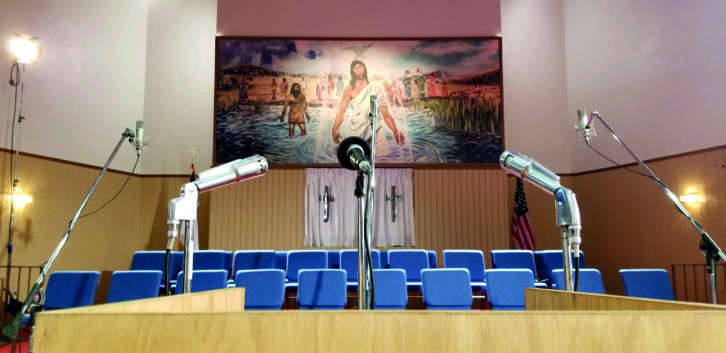
MIXING MUSIC FOR THE SPACE
With the wide variety of venues seen throughout the series—everything from intimate recording studios to large halls—Brennan had to create specific environments for each. Using Exponential Audio Stratus 3D and Symphony 3D reverbs, he says, he would build the rooms with appropriate echo and space. “I really tried to bounce off that back, to get that back-of-the-concert-hall kind of slap, where you hear the kick drum and snare bounce off that back wall. ‘Cause that’s the thing that always drops me in the space.”
He would also grab Audio Ease Altiverb 7 and Exponential Audio PhoenixVerb to “build a little P.A. system, with maybe a little bit of distortion, like older P.A. systems had out on a tour. I would normally start with the mix from the album because that’s still what everyone’s referencing in their head, especially on better-known songs. And then it was a matter of, ‘Okay let’s put it in this venue. Let’s get it really feeling the space.’”
For the “Amazing Grace” music scenes, Brennan even went to the effort of hiring a loop group to add in shout-outs from the crowd, as he had seen in the documentary shot of the recording. “It really gets you this great call-and-response energy back and forth.”
The resultant recordings provide something that’s far more than basic re-creations of Aretha Franklin’s recordings. They help reveal her true genius, all from her own experience, as the Genius series has done for three seasons.
“There was a lot of care and attention that was put into totally honoring what her legacy is and what this work is,” says music supervisor Ross. “It’s far more about the heartbeat of Aretha’s music legacy. It’s the genius of Aretha.”
